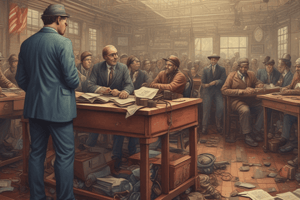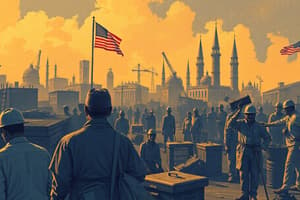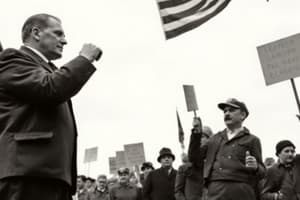Podcast
Questions and Answers
What was the primary goal of the American Federation of Labor (AFL) when it was founded?
What was the primary goal of the American Federation of Labor (AFL) when it was founded?
- To abolish private property and establish a socialist state in the United States.
- To organize skilled workers into trade-specific unions to improve their working conditions. (correct)
- To advocate for the interests of farmers and agricultural workers exclusively.
- To unite all workers, regardless of skill, into one large national union.
Which event led to the collapse of the Homestead Strike in 1892?
Which event led to the collapse of the Homestead Strike in 1892?
- Public support shifting against the steelworkers due to violent protests.
- A failed assassination attempt on the plant manager, Henry Frick. (correct)
- The intervention of federal troops to protect the steel factory.
- A successful negotiation between workers and Andrew Carnegie.
What was the key reason President Grover Cleveland ordered federal troops to intervene in the Pullman Strike of 1894?
What was the key reason President Grover Cleveland ordered federal troops to intervene in the Pullman Strike of 1894?
- To support the Pullman railcar company against the striking workers.
- To prevent violence and maintain public order in Chicago.
- To enforce a court injunction against the striking workers and their union leaders.
- To ensure the continuous delivery of mail, which was being disrupted by the strike. (correct)
What role did the Interstate Commerce Commission (ICC) play in regulating the railroad industry?
What role did the Interstate Commerce Commission (ICC) play in regulating the railroad industry?
Which of the following was a prominent demand of the Populist movement?
Which of the following was a prominent demand of the Populist movement?
Which factor contributed most significantly to the Depression of 1893?
Which factor contributed most significantly to the Depression of 1893?
What was the main objective of Coxey's Army's march on Washington, D.C. in 1894?
What was the main objective of Coxey's Army's march on Washington, D.C. in 1894?
Which of the following describes a key change in the American workplace due to industrialization?
Which of the following describes a key change in the American workplace due to industrialization?
What primary economic factor contributed to the struggles of American farmers in the late nineteenth century?
What primary economic factor contributed to the struggles of American farmers in the late nineteenth century?
How did the monopolistic practices of railroads and grain storage companies affect farmers in the late 19th century?
How did the monopolistic practices of railroads and grain storage companies affect farmers in the late 19th century?
What was a key difference in the approaches taken by farmers and industrial workers to address their economic hardships in the late nineteenth century?
What was a key difference in the approaches taken by farmers and industrial workers to address their economic hardships in the late nineteenth century?
Which approach reflects a strategy employed by industrial workers in the late 19th century to combat economic hardship?
Which approach reflects a strategy employed by industrial workers in the late 19th century to combat economic hardship?
What was the primary political outcome of the Depression of 1893 regarding party dominance in the United States?
What was the primary political outcome of the Depression of 1893 regarding party dominance in the United States?
What was the main reason for the collapse of the Populist Party after the Depression of 1893?
What was the main reason for the collapse of the Populist Party after the Depression of 1893?
What methods did Southern Democrats employ to consolidate their power in the aftermath of the Depression of 1893?
What methods did Southern Democrats employ to consolidate their power in the aftermath of the Depression of 1893?
How did the Depression of 1893 impact the long-term political alignment in the United States?
How did the Depression of 1893 impact the long-term political alignment in the United States?
Flashcards
Late 19th Century Farmer Hardships
Late 19th Century Farmer Hardships
Decline in crop prices, high debt, and unstable economy.
Farmer Financial Strain
Farmer Financial Strain
Monopolies held by railroads and grain storage companies.
Grangers and Farmers’ Alliances
Grangers and Farmers’ Alliances
Organizations that offered farmers collective support.
Organizing Differences (Farmers vs. Workers)
Organizing Differences (Farmers vs. Workers)
Signup and view all the flashcards
Primary Focus (Farmers vs. Workers)
Primary Focus (Farmers vs. Workers)
Signup and view all the flashcards
Political Realignment after 1893
Political Realignment after 1893
Signup and view all the flashcards
Populist Party Collapse
Populist Party Collapse
Signup and view all the flashcards
Voter Suppression in the South
Voter Suppression in the South
Signup and view all the flashcards
Haymarket Square Riot
Haymarket Square Riot
Signup and view all the flashcards
American Federation of Labor (AFL)
American Federation of Labor (AFL)
Signup and view all the flashcards
Homestead Strike
Homestead Strike
Signup and view all the flashcards
Pullman Strike
Pullman Strike
Signup and view all the flashcards
Interstate Commerce Commission (ICC)
Interstate Commerce Commission (ICC)
Signup and view all the flashcards
Populists
Populists
Signup and view all the flashcards
Depression of 1893
Depression of 1893
Signup and view all the flashcards
Coxey's Army
Coxey's Army
Signup and view all the flashcards
Study Notes
- Haymarket Square Riots occurred in Chicago on May 4, 1886.
- 7 policemen and 4 protesters died during clashes between police and anarchists protesting police violence who were trying to disrupt strikes.
- The American Federation of Labor (AFL) was a trade union founded in 1886 by Samuel Gompers.
- AFL aimed to unite skilled workers into trade-specific unions.
- The Homestead strike was an 1892 strike involving steelworkers at Andrew Carnegie's Homestead steel factory, near Pittsburgh, PA.
- The Homestead strike collapsed following a failed assassination attempt on the plant manager, Henry Frick.
- The Pullman strike was an 1894 strike by workers against the Pullman railcar company.
- President Grover Cleveland sent federal troops to resume rail service after the Pullman strike disrupted it nationwide, threatening mail delivery after the strike.
- The Interstate Commerce Commission (ICC) was established by Congress in 1887 as a regulatory commission.
- The ICC investigated interstate shipping, mandated that railroads publicize their rates, and pursued lawsuits to lower "unreasonable" fares for shippers.
- Populists aimed to attract both farmers and industrial workers by promoting a graduated income tax, an 8-hour workday, immigration restriction, and women's suffrage.
- The Depression of 1893 was a severe economic downturn triggered by railroad and bank failures.
- The Depression of 1893, along with the limited federal response, led to a realignment of American politics
- Coxey's Army, a protest movement in spring 1894, was led by populist reformer Jacob Coxey.
- Coxey, with five hundred supporters, marched from Ohio to Washington, D.C., to protest the government's insufficient response to the Depression of 1893.
Industrialization's Impact on the American Workplace
- Industrialization transformed the American workplace from small-scale, skilled labor to large-scale factory production using machines and assembly lines.
- While industrialization increased efficiency, it also led to repetitive, specialized tasks for workers.
- Industrialization created challenges like poor working conditions, long hours, low wages, and job insecurity due to mechanization replacing skilled labor.
- Labor unions emerged in response to these hardships to advocate for workers' rights.
Hardships Faced by American Farmers in the Late Nineteenth Century
- American farmers faced hardships in the late nineteenth century due to falling crop prices, rising debt, and economic instability from overproduction.
- Railroads and grain storage companies, often monopolies, charged high rates, increasing farmers' financial strain.
- Isolation and limited social interaction made rural life challenging, leading farmers to seek collective support via organizations like the Grangers and Farmers' Alliances.
Similarities and Differences in Farmers' and Industrial Workers' Organizing Efforts
- Both farmers and industrial workers organized to combat economic hardship and political disenfranchisement, but their approaches differed.
- Industrial workers formed labor unions to demand better wages, hours, and working conditions.
- Farmers formed cooperatives and alliances to combat low crop prices, high railroad fees, and debt.
- Farmers focused more on political solutions like the subtreasury system and regulation.
- Industrial workers primarily sought labor rights through strikes and collective bargaining.
Long-Term Political Consequences of the Depression of 1893
- The Depression of 1893 led to a major political realignment, with Republicans dominating from 1896 to 1932 by forming a coalition of big business and urban workers.
- The Populist Party collapsed after failing to unite farmers and industrial workers, although its reform ideas influenced the Progressive Era.
- In the South, Democrats reinforced power by implementing voter suppression laws, like literacy tests and poll taxes, to disenfranchise Black and poor white voters.
- Post Depression of 1893, the divide between industrial and agrarian interests shaped American politics for decades.
Studying That Suits You
Use AI to generate personalized quizzes and flashcards to suit your learning preferences.
Related Documents
Description
Overview of labor history in the late 19th century United States. Covers the Haymarket Square Riot, the American Federation of Labor, the Homestead Strike, the Pullman Strike, and the establishment of the Interstate Commerce Commission.




